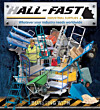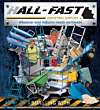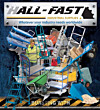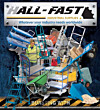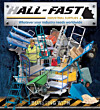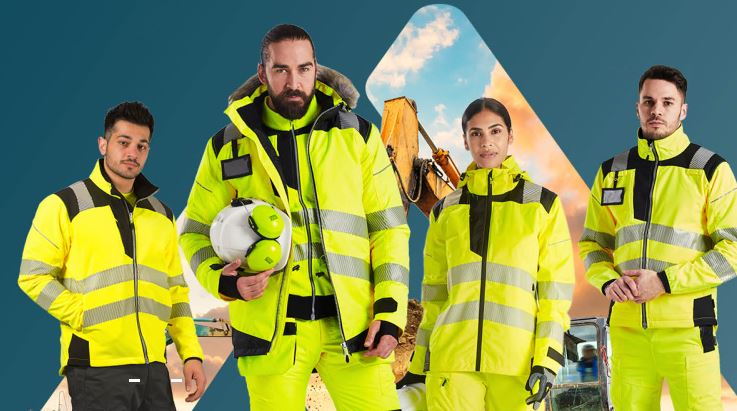
The Critical Need for Multi-Hazard Protection
Modern industrial environments often present workers with multiple simultaneous hazards that require comprehensive protection strategies. Workers in petrochemical facilities, electrical utilities, transportation, and construction frequently face both visibility hazards and fire/thermal risks that demand specialized protective clothing combining hi-visibility and NFPA compliance features.
Traditional safety approaches often addressed these hazards separately, requiring workers to choose between different types of protection or layer multiple garments that could compromise mobility and comfort. The development of multi-hazard garments that meet both hi-visibility standards and NFPA requirements represents a significant advancement in worker protection technology.
Hall-Fast, drawing on nearly two decades of experience in industrial safety since August 2006, understands the complexity of multi-hazard environments and the importance of integrated protection solutions. Their partnership with Portwest provides access to advanced hi-visibility, NFPA compliant workwear that addresses multiple hazards without compromising on either protection aspect.
The company's expertise in serving diverse industries has given them unique insights into the practical challenges of implementing effective multi-hazard protection programs, making them invaluable partners for businesses seeking comprehensive worker protection solutions.
Understanding Hi-Visibility Standards and Requirements
Hi-visibility workwear standards, including EN ISO 20471 and ANSI/ISEA 107, establish requirements for garments designed to enhance worker visibility in low-light conditions and around moving vehicles or equipment. These standards specify requirements for fluorescent background materials, retroreflective tape placement, and overall garment design to ensure optimal visibility performance.
Class 1 hi-visibility garments provide basic visibility enhancement suitable for controlled environments with minimal traffic and good lighting conditions. These garments typically feature limited amounts of fluorescent material and retroreflective tape, making them appropriate for lower-risk visibility applications.
Class 2 hi-visibility garments offer increased visibility through larger areas of fluorescent material and additional retroreflective tape placement. This level is suitable for moderate-risk environments with moving equipment and varying lighting conditions, providing enhanced protection over Class 1 options.
Class 3 hi-visibility garments provide maximum visibility through extensive fluorescent material coverage and comprehensive retroreflective tape patterns. This highest level is required for high-risk environments such as highway work zones and industrial facilities with heavy equipment traffic.
NFPA Compliance in Hi-Visibility Applications
Combining hi-visibility features with NFPA compliance presents unique technical challenges, as traditional hi-visibility materials may not meet flame resistance requirements. Specialized materials and construction techniques are required to achieve both objectives without compromising either protection aspect.
Flame-resistant fluorescent fabrics maintain their hi-visibility properties while providing thermal protection according to NFPA standards. These specialized materials undergo extensive testing to verify both visibility performance and flame resistance characteristics, ensuring dual protection effectiveness.
Retroreflective tape used on NFPA compliant garments must also meet flame resistance requirements. This specialized tape maintains its reflective properties while providing appropriate thermal protection during fire exposure, ensuring comprehensive protection integration.
Construction techniques for dual-protection garments must consider the interaction between hi-visibility features and flame resistance. Seam placement, tape attachment methods, and overall design must support both protection objectives while maintaining garment durability and performance.
Industries Requiring Dual Hi-Visibility and NFPA Protection
Oil and gas operations frequently require workers to have both hi-visibility and flame protection due to the combination of vehicular traffic and fire hazards. Refinery workers, pipeline crews, and offshore personnel often work in environments where both hazards are present simultaneously, making dual protection essential.
Electrical utilities present classic examples of dual-hazard environments where workers face arc flash risks while working near roadways or in equipment yards with moving vehicles. Line crews, substation workers, and maintenance personnel require protection against both electrical hazards and vehicle strikes.
Transportation and logistics facilities, particularly those handling flammable materials, create environments where workers need protection from both moving vehicles and potential fire hazards. Rail yards, tank truck terminals, and chemical distribution facilities exemplify these dual-hazard environments.
Emergency response personnel, including fire service and hazmat teams, often require hi-visibility and flame protection when working incident scenes involving both traffic control and fire/chemical hazards, making integrated protection solutions particularly valuable.
Portwest Hi-Visibility NFPA Compliant Solutions
Portwest's hi-visibility NFPA compliant range available through Hall-Fast provides comprehensive solutions for multi-hazard environments. These garments combine proven hi-visibility technology with reliable flame resistance to deliver integrated protection that meets both safety objectives.
Hi-visibility flame-resistant coveralls provide full-body protection with maximum visibility features. These garments incorporate extensive fluorescent material coverage with strategically placed retroreflective tape while maintaining NFPA compliance for thermal protection. For more information about coverall options, visit https://www.hall-fast.com/safety-at-work/workwear/portwest-workwear/coverall-portwest.
Hi-visibility flame-resistant shirts and trousers offer flexibility for workers who need different protection levels throughout their workday. The ability to mix and match components allows for customized protection based on specific task requirements and hazard exposures while maintaining both protection aspects.
Hi-visibility flame-resistant outerwear provides weather protection while maintaining both visibility and thermal protection characteristics. These garments enable year-round protection regardless of environmental conditions, ensuring consistent worker protection.
Specialized hi-visibility flame-resistant garments address unique industry requirements, including rail-specific designs that meet both visibility and thermal protection standards required for railway workers. Visit https://www.hall-fast.com/safety-at-work/workwear/portwest-workwear/portwest-hi-visibility-rail for rail-specific options.
Design Considerations for Dual-Protection Garments
Garment design for dual hi-visibility and NFPA protection requires careful consideration of how different protective features interact and complement each other. Design decisions impact both protection effectiveness and wearer comfort and functionality.
Retroreflective tape placement must provide optimal visibility enhancement while avoiding areas that could be damaged during normal work activities. Strategic placement ensures long-term visibility performance while maintaining flame resistance integrity throughout the garment's service life.
Fluorescent material distribution should maximize visibility while maintaining garment durability and comfort. Proper material selection and placement enhance visibility without creating weak points or areas prone to excessive wear that could compromise protection.
Color selection for flame-resistant hi-visibility garments typically focuses on fluorescent orange or yellow-green materials that provide optimal visibility while meeting flame resistance requirements. These colors must maintain their visibility properties throughout the garment's service life.
Ergonomic considerations ensure dual-protection garments accommodate the full range of motion required for various work tasks while maintaining both protection aspects. Proper fit and design features support worker productivity and comfort without compromising safety.
Performance Testing and Certification
Dual-protection garments must undergo comprehensive testing to verify compliance with both hi-visibility and NFPA standards. This testing ensures that neither protection aspect is compromised in the combined garment design, providing reliable integrated protection.
Hi-visibility testing verifies fluorescent material performance, retroreflective characteristics, and overall visibility effectiveness under various lighting conditions. This testing ensures garments meet applicable visibility standards throughout their service life while maintaining flame resistance.
NFPA testing confirms flame resistance properties, thermal protective performance, and overall compliance with applicable flame resistance standards. This testing ensures reliable thermal protection regardless of hi-visibility features integrated into the garment design.
Durability testing evaluates how repeated laundering, wear, and environmental exposure affect both hi-visibility and flame resistance properties. This testing helps predict garment service life and replacement requirements for effective program management.
Integration testing examines how different protective features interact and whether their combination affects overall performance. This specialized testing ensures optimal protection from combined garment designs while maintaining both protection aspects.
Workplace Implementation Strategies
Successful implementation of dual-protection workwear requires careful planning, training, and ongoing management to ensure maximum safety benefits. Implementation strategies should address both technical and practical aspects of program deployment while considering worker acceptance and compliance.
Hazard assessment for dual-protection environments must identify and evaluate both visibility and thermal hazards to determine appropriate protection levels. This assessment forms the foundation for garment selection and program design, ensuring comprehensive hazard coverage.
Training programs should address the unique aspects of dual-protection garments, including proper care, inspection procedures, and limitations of combined protection features. Workers need to understand both protection aspects to use garments effectively and maintain safety.
Program management systems help track garment performance, replacement schedules, and compliance with both hi-visibility and NFPA requirements. These systems ensure consistent protection levels throughout the program lifecycle while facilitating continuous improvement.
Quality assurance procedures verify that garments maintain both protection aspects throughout their service life. Regular inspection and testing help identify garments that may have lost effectiveness in either protection area, preventing exposure to hazards.
Cost-Effectiveness of Integrated Protection
Dual-protection garments often provide cost advantages compared to separate garments for each hazard type, while also improving worker comfort and compliance. Understanding the total cost impact helps justify program investments and demonstrates value to stakeholders.
Initial cost comparisons should consider the expense of dual-protection garments versus separate hi-visibility and flame-resistant garments. While dual-protection garments may have higher individual costs, the total program cost is often lower due to simplified procurement and management.
Maintenance and replacement costs for integrated protection may be lower due to simplified inventory management, reduced laundering complexity, and unified replacement schedules. These operational efficiencies provide ongoing cost benefits throughout the program lifecycle.
Productivity benefits result from improved worker comfort and reduced complexity of protection programs. Workers with integrated protection can focus on their tasks rather than managing multiple garments, improving both efficiency and safety compliance.
Compliance benefits include simplified program administration, reduced training requirements, and lower risk of protection gaps that could occur when workers must choose between different protection types during various tasks.
Environmental Considerations and Durability
Dual-protection garments must maintain both hi-visibility and flame resistance properties under various environmental conditions and throughout extended service life. Environmental factors can significantly impact garment performance and require careful consideration in program design.
UV exposure can degrade both fluorescent materials and flame-resistant properties over time. Garment design and material selection should consider expected UV exposure levels and include appropriate protective measures to maintain long-term performance.
Chemical exposure in industrial environments may affect both hi-visibility and flame resistance characteristics. Understanding potential chemical exposures helps in selecting appropriate garment materials and establishing proper care procedures to maintain protection effectiveness.
Mechanical wear from normal work activities can impact retroreflective tape adhesion, fluorescent material integrity, and flame-resistant properties. Design features should minimize wear in critical areas while maintaining protection effectiveness throughout the garment's service life.
Laundering effects on dual-protection garments require specialized care procedures that preserve both protection aspects. Industrial laundering services experienced with multi-hazard garments often provide the most reliable care to maintain protection integrity.
Technology Advancements in Multi-Hazard Protection
Ongoing developments in material science and garment technology continue to improve the performance and comfort of dual-protection workwear. These advancements address previous limitations while enhancing protection effectiveness and worker acceptance.
Advanced fluorescent materials provide improved color retention, enhanced durability, and better integration with flame-resistant base fabrics. These materials maintain visibility performance longer while supporting NFPA compliance, providing better long-term value.
Innovative retroreflective technologies offer improved visibility characteristics while meeting flame resistance requirements. New tape formulations and attachment methods provide enhanced durability and protection integration while maintaining visibility performance.
Fabric technology improvements deliver better moisture management, improved comfort, and enhanced durability while maintaining both hi-visibility and flame resistance properties. These advancements support worker comfort and compliance while ensuring protection effectiveness.
Construction innovations enable better integration of protective features while improving garment fit, comfort, and functionality for demanding work environments. These improvements enhance both protection and user acceptance.
Global Standards and International Markets
Understanding various international standards for both hi-visibility and flame resistance helps ensure appropriate protection for global operations. Different regions may have specific requirements that impact garment selection and program design for international businesses.
European standards, including EN ISO 20471 for hi-visibility and various EN standards for flame resistance, provide frameworks for dual-protection garments used in European markets. Understanding these standards facilitates international business operations.
North American standards, including ANSI/ISEA 107 for hi-visibility and NFPA standards for flame resistance, establish requirements for dual-protection garments used in US and Canadian operations. Compliance with these standards ensures appropriate protection.
International harmonization efforts aim to create consistent standards that facilitate global commerce while ensuring appropriate worker protection regardless of location. These efforts support multinational operations and global supply chain management.
Hall-Fast's Multi-Hazard Expertise
Hall-Fast's comprehensive understanding of multi-hazard environments, developed through nearly twenty years of serving diverse industries, provides customers with expert guidance in implementing effective dual-protection programs. Their experience spans multiple industry sectors and protection requirements.
Technical support services help customers navigate the complexities of multi-hazard assessment, garment selection, and program implementation. This support ensures customers receive appropriate solutions for their specific multi-hazard environments while maintaining cost-effectiveness.
Training resources complement protective equipment sales by helping customers understand the unique aspects of dual-protection garments and develop effective implementation strategies. These resources enhance program effectiveness and worker safety.
International experience enables Hall-Fast to serve customers worldwide while ensuring compliance with local standards and requirements for both hi-visibility and flame resistance protection. Their global perspective supports international business operations.
For more information about Hall-Fast's expertise and capabilities, visit https://www.hall-fast.com/about to learn about their extensive experience in multi-hazard protection and commitment to customer service excellence.
Quality Assurance and Performance Monitoring
Hall-Fast's quality assurance processes ensure dual-protection garments meet both hi-visibility and NFPA requirements while maintaining consistent performance throughout their service life. These processes support program effectiveness and worker protection.
Supplier partnerships with manufacturers like Portwest provide access to proven dual-protection technologies backed by comprehensive testing and certification programs. These partnerships ensure product quality and performance reliability.
Performance monitoring systems help track garment effectiveness and identify any issues that may impact either protection aspect. This monitoring supports continuous improvement in protection programs while ensuring ongoing compliance.
Customer support services provide ongoing assistance with program management, performance monitoring, and optimization of dual-protection strategies. This support ensures customers receive maximum value from their protection investments.
Specialized Applications and Industry Solutions
Different industries may require specific combinations of hi-visibility and flame resistance features. Construction applications often require Class 3 hi-visibility with basic flame resistance, while petrochemical applications may need higher thermal protection levels with Class 2 visibility.
Rail industry applications have specific requirements for both visibility and flame resistance, with specialized design features for railway work environments. These applications often require enhanced durability and specific color requirements for rail safety compliance.
Emergency response applications may require rapid deployment capabilities combined with maximum protection levels. These specialized applications often need enhanced features for extreme conditions and emergency response scenarios.
Future Trends in Dual-Protection Workwear
Emerging technologies continue to advance dual-protection capabilities while improving comfort and functionality. Smart materials may eventually provide adaptive protection that adjusts to environmental conditions and hazard levels.
Sustainability considerations are driving development of more environmentally friendly dual-protection solutions. These innovations maintain safety performance while reducing environmental impact throughout the garment lifecycle.
Integration with other safety technologies, such as monitoring systems and communication devices, may provide comprehensive safety solutions that enhance both protection and operational efficiency in hazardous environments.
Conclusion
The combination of hi-visibility and NFPA compliance in integrated workwear represents a significant advancement in worker protection that addresses the reality of multi-hazard work environments. These sophisticated garments provide comprehensive protection while improving comfort and compliance compared to separate protection systems.
Portwest's dual-protection solutions, available through Hall-Fast's expert distribution network, provide reliable integrated protection backed by comprehensive testing and certification. Their advanced design and construction techniques ensure optimal performance in both protection areas.
Hall-Fast's expertise in multi-hazard environments, combined with their commitment to customer service and technical support, makes them an ideal partner for implementing effective dual-protection programs. Their understanding of both technical requirements and practical applications ensures customers receive solutions that enhance safety while supporting productivity.
The investment in quality dual-protection workwear provides significant benefits through improved safety, simplified program administration, and enhanced worker acceptance. Hall-Fast's comprehensive approach to customer support helps ensure these benefits are realized in actual workplace applications.
For detailed information about hi-visibility NFPA compliant workwear options, visit https://www.hall-fast.com/safety-at-work/workwear/portwest-workwear/portwest-hi-visibility to explore available solutions or contact Hall-Fast at https://www.hall-fast.com/contact for expert guidance on multi-hazard protection requirements and implementation strategies.



